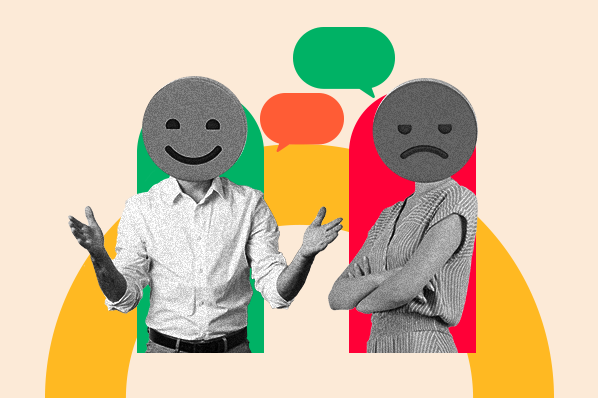Examples of Good vs. Bad Customer Service
Before diving into my experiences at each hotel, let's identify each one as Hotel A and Hotel B. Hotel A had great service, while Hotel B did not.
Example of Good Customer Service
At Hotel A, breakfast would be served in five courses. Despite being delicious food, one morning I didn't want anything on the menu. Dimitri -- we knew the staff by name -- responded immediately with, "No problem! What would you like instead? The kitchen can prepare anything."
There wasn't any hesitation in offering me a solution to my problem. Within a few minutes, my avocado toast with a poached egg was delivered. Suffice to say, I was a very happy guest.
Every day, we would find our loungers by the pool and as soon as we laid down, one of the waiters would deliver us our favorite drinks. There was no need for us to explicitly order them as the staff got to know our routine and we were glad to accept the drinks. We would spend time having conversations with the staff, getting to know one another and genuinely enjoying their company.
Hotel A was beautiful, but what truly sets it apart was the standard of service it delivers. It was simply faultless. Now let's compare that to Hotel B.
Example of Bad Customer Service
Hotel B was wonderful, the food was excellent, the rooms were supremely comfortable and the hotel itself is beautifully designed. We enjoyed our stay and the facilities were great. So, what was different?
For starters, we ordered coffees at our sun loungers. It was windier than usual and as the wind picked up, it took with it my husband's full-to-the-brim coffee. It went all over his towel and lounger.
We signaled for assistance and a waitress hurried over. When we explained the situation, her immediate response was, "Are you willing to pay for this coffee?"
You could see the panic on the waitress's face as it was clear that she was completely unsure of how to handle the situation. When we -- rather awkwardly -- replied by saying that we hoped to get a replacement coffee, ideally free of charge, it took three staff members to assess the situation before the manager was called over. Immediately, he ordered us a replacement coffee.
My husband and I chatted about our experiences at each hotel. We both agreed that the situation at Hotel B was handled poorly, despite its ultimately good outcome. How could such a wonderful hotel have such arduous processes in place for rectifying minor mistakes? It wasn't long into our chat when we both realized the key difference was between the two companies.
The Difference Between Good vs. Bad Customer Service
The staff at Hotel A, regardless of seniority, were encouraged to think on their feet and apply common sense to resolve situations. It wasn't that nothing ever went wrong at Hotel A, but rather staff members were able to solve problems by themselves. In short, they were given the autonomy to do their jobs to the highest standard. This seems to be a theme with most businesses that are known for their good customer service.
Conversely, at Hotel B, it became clear that management were the only people applying common sense to situations and making decisions. Because of this, if anything went wrong none of the junior staff members were able to do anything. This created unnecessary drama and angst.
Why Bad Customer Service Occurs
In hindsight, it's easy to criticize Hotel B for their customer service protocol. In fact, you may be wondering why an organization would resort to such an inefficient approach. However, there are a few factors that could have led to this system and they could easily affect your business as well.
- Junior members don't have as much responsibility or expertise as management or aren't paid enough to make decisions.
- In the past, junior members were allowed to make decisions and made poor choices.
- Not everyone has common sense, so it's easier to standardize the processes and elect management to make decisions.
The first two reasons can be corrected with proper hiring and training. Staffing your teams with trustworthy employees is critical to customer service. If you can't trust reps to make their own decisions, they'll end up encountering bottlenecks and data silos when trying to resolve basic customer service issues.
The last reason on this list is a problem that growing organizations often face. As they hire more employees, they need to ensure a consistent experience for their customers. However, as you standardize your company's processes, you may lose personalization elements that made your brand successful.
In the next section, let's talk about how you can maintain that high-quality level of customer service as you grow your customer base.
How to Maintain Good Customer Service
While customer expectations remain the same for growing businesses, the focus of customer service shifts as companies increase in size.
1. Balance personalization with efficiency.
With smaller companies, customers expect personalized customer service. There are fewer people to remember, from both the perspective of the employee and the customer, so forming strong relationships is easier.
With growing companies, customers understand that service may be less personalized, but is more efficient because the company has more resources. This means that customer service problems should be resolved quickly and at little expense to the customer. For example, this is why we expect refunds to be processed faster by larger companies.
2. Value every customer's experience.
In the case of #CoffeeGate, the result was positive; we got our replacement coffee free of charge, which we were happy about. However, the overall experience didn't match up to our expectations. It was about the way the service was delivered that left us with a sour taste.
We felt that the company's motivation boiled down to money. How much would it cost to replace the coffee? Were we willing to pay for the original one? How were they going to sort out the bill?
It felt cold because we were no longer valued customers. Instead, we were just some arbitrary guests costing the business money. It's situations like these where customer service teams need to assess the situation and provide an appropriate response. While large organizations have protocol for a reason, these rules shouldn't contribute to a negative customer experience, especially when it's over a trivial matter.
3. Hire motivated staff.
At Hotel A, you got the feeling that the staff enjoyed their work. It felt like they were always happy to help when needed. In return, customers enjoyed spending time with them because the environment felt relaxed and happy. Because the staff liked their jobs, they contributed to a positive customer experience. And, the result?
We spent more money and we would go back and do it over and over again.
4. Use customer service to complement sales.
Great businesses recognize that customer service isn't cost-centered. Instead, going the extra mile to provide great customer service creates its own sales opportunities. For example, customers who experience excellent service are more likely to purchase again and spend 17% more with your company. Not only do customers remember positive experiences, but service reps also have the opportunity to upsell and cross-sell.
Excellent customer service isn't about procedure and protocol, it's about how you make your customers feel. Get that right, and they'll be loyal to your brand for a long time. And if in doubt, here's a good rule of thumb: if the wind blows your customer's coffee over, get them a new one.
If you're looking to avoid a service catastrophe like this one, read how you can improve customer experience.
Customer Centric Marketing
.png?width=112&height=112&name=Image%20Hackathon%20%E2%80%93%20Vertical%20(9).png)

